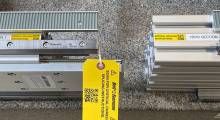From Toll House cookies to sports nutrition to pet care, Nestlé is a leading global provider of food and wellness products and a household name. So it comes as no surprise that Nestlé’s high-volume DC stores and distributes hundreds of SKUs from its consumer food and beverage, food service and pet food businesses.
The high demand for Nestlé’s household brands means that about 80% of its DC’s orders are distributed as full pallets. But picking the remaining 20%, which are distributed in pallet layer and full case quantities, involved the manual handling of about five million cases per year. This created a significant, ongoing ergonomic challenge, not to mention a productivity challenge.
To address those challenges, Nestlé installed a layer picking solution (Dematic, dematic.com) that eliminates the need to manually handle about four million cases. The robotic layer picking system achieves picking efficiency by removing layers from one pallet then creates the right case layer quantity for another order. By cross-matching orders and pairing those with compatible order profiles, the system enables about 20%, and in some instances up to 50%, of cases for orders to be distributed without each layer being physically picked.
Orders from Nestlé’s warehouse management system are downloaded to the warehouse control system to initiate picking. The system calls for the stock required for layer picking in the sequence required to fulfill the next wave of orders. Full pallets are retrieved from adjacent bays of reserve storage by RF-directed forklifts and loaded onto the induction conveyor. As pallets are fed into the layer picking cell, they are scanned and the control system directs the operator to remove the required amount of stretchwrapping from the pallet.
As new pallets of stock are fed into the system, the layer picker selects the required layers and transfers the stock to one of four customer order pallets. Any stock remaining on a pallet either forms the basis for another order through the system software, or is returned to the reserve storage bays.
Orders that need additional case picks to be added to the layers exit the robotic cell. From there, operators add the cases needed to complete the order.
Since implementing the new systems, Nestlé has created a safer workplace by reducing forklift operations and ergonomic risks associated with manually pallitizing. In addition, the system’s pallet build quality has improved transport utilization and resulted in less product damage and fewer returns, all of which have reduced Nestlé’s distribution operating costs.
About the Author
Follow Robotics 24/7 on Linkedin
About the Author
Follow Robotics 24/7 on Linkedin
Article topics
Email Sign Up















